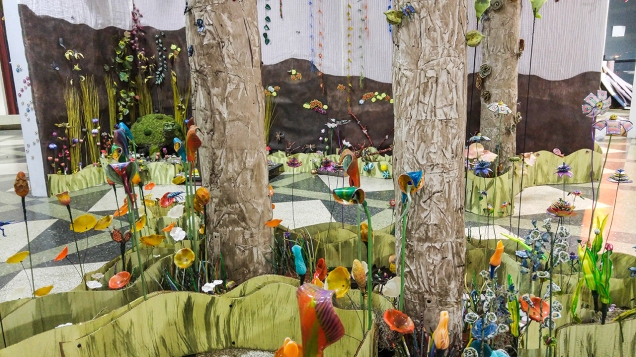Impressions of the Forest from guest writer, Ronna Sarvas Weltman.

I love alchemy. I love the word’s medieval origins, a belief in the possibility of transformation of matter. The term evokes ancient labs, bubbling brew, vials readied for a magic charm. And I love modern alchemy, especially when humble materials are transformed into magic.
That’s what I found when I visited Into the Forest. I expected to find a bunch of stuff made out of polymer clay. I thought it would be interesting. What I found instead was an other-worldly space that made me question my assumptions about how our world is ordered. Alchemy, it seemed to suggest, is real.
As I wandered through, looking at individual pieces, looking at sections as a whole, and then wandered through from the other direction so I could see it from another angle, I had the oddest sensation. It felt like every single piece had a soul. Of course that makes no sense — it’s polymer clay, folks — and yet. It felt as if each piece belonged with every other piece, representing the hopes and wishes of their creators. Laura, Emily and Julie’s call to the international community to share their creative, hopeful, energetic and generous artistic voices brought in an astonishingly diverse mix of creations.
Whenever I’m designing jewelry, I’m thinking about how the different elements work together. Do the colors, textures, sizes and shapes harmonize with each other? What piece is the focal? Which are the supporting players? There are certain rules, you know.
Into the Forest turned that onto its head. There were no star players here, supporting cast there. Instead, I found an enchanted blend gathered in stunning harmony, a remarkable whole infinitely greater than the sum of its parts. Or maybe it’s because the parts here infuse the materials. The parts include the call to the world community to send their own interpretation of organic elements. The parts include pieces made by accomplished artists, by crafters newly exploring polymer, even by incarcerated women barred from using the most basic tools. The parts include a cadre of volunteers spending countless hours attaching bits to pieces, valuing every piece, building a world where art weaves a magic spell, pointing us to possibilities, shifting our assumptions.
The global polymer clay community is a remarkably engaged group that shares words, images, ideas. Social media has enabled members of our tribe to encourage each other, foster each others’ artistic growth. But words, images and ideas exist in a fleeting universe. Into the Forest enabled us to actually share our work. It was a big party of everybody, where everyone’s work was equally included. Crafters with emerging skills — and emerging confidence — overcame fears of “not good enough” to send their work. Their work is critical to the exhibit’s charm and success. And the achievement can be experienced and celebrated in a real space, in real life.
The whimsical design of Into the Forest gives it an ephemeral feel. And of course, literally, it is — it is a temporary exhibit. I hope that it moves on to other cities, even other countries, but in the meantime the magic, the ephemera, are the proof that alchemy does indeed exist, maybe more than ever.